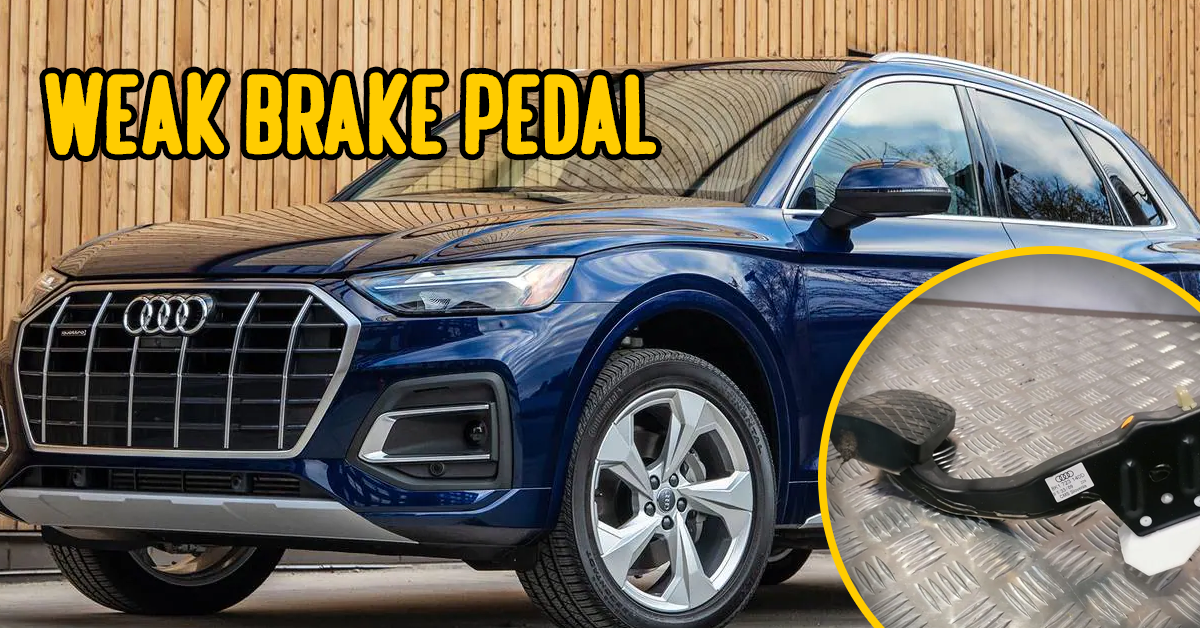The brake system is one of any vehicle’s most important safety features, including the Audi Q5. Proper brake functioning is essential in Audis and all cars, spelling the difference between life and death. Your brakes can minimize damage in an emergency, whether a fender bender or a major collision. With any luck, they will prevent a collision, resulting in quick handling and stopping. In addition, properly functioning brakes also help you maintain the control and stability of the vehicle, particularly at high speeds.
If you’ve noticed that your Audi Q5’s brake pedal feels spongy or soft, it’s important to address the issue immediately. Fluid pressure in the master cylinder and the brake lines creates the “feel” of your brake pedal. When you press the pedal to slow or stop, the brake pads are engaged and cause friction, which slows the vehicle down. If the brake pedal feels spongy or soft, a problem with the system must be identified and repaired immediately. Other common symptoms of a weak brake pedal include squealing or grinding noises when applying the brakes, poor brake performance, and vibration or pulling while driving.
Causes of a weak brake pedal in Audi Q5
Air in the brake lines
Air in the brake lines is the most common cause of a soft or spongy brake pedal. Air can enter the system through a leak or during brake repairs that were not properly performed.
Worn or damaged brake pads
Worn or damaged brake pads can also cause a weak brake pedal. When you press on the brake pedal, the pads become engaged and cause friction, which slows the vehicle down. If the pads are worn or damaged, they may not be able to create enough friction to slow the vehicle down properly.
Faulty brake master cylinder
The brake master cylinder is responsible for creating the hydraulic pressure that engages the brake pads. If the master cylinder is faulty, it may not be able to create enough pressure to engage the pads properly, resulting in a weak brake pedal.
Brake fluid leaks
Brake fluid leaks can also cause a weak brake pedal. If there is a leak in the brake system, the fluid level can drop, which can cause a loss of pressure in the system and a weak brake pedal. Contaminated or bad brake fluid can also cause poor brake performance, which requires a brake flush.
DIY Tips for Diagnosing a weak brake pedal
Bleeding the brake system
To check for air in the brake lines, you can bleed the brake system. This involves removing the old brake fluid and replacing it with new fluid while removing any air bubbles that may be present in the system. Bleeding the brake system is something that anyone who’s even marginally handy with tools can accomplish at home with the help of an able assistant.
Replacing worn or damaged brake pads
To inspect brake pads for wear and damage, you can remove the wheels and visually inspect the pads. If the pads are worn or damaged, they may not create enough friction to slow the vehicle down properly. In this case, we should replace the pads.
Identifying signs of a faulty master cylinder
To evaluate the brake master cylinder, you can check for signs of a faulty master cylinder, such as a low brake pedal or a brake pedal that sinks to the floor.
Replacing the brake master cylinder if necessary
If the master cylinder is faulty, it may need to be replaced. This is a more complex repair that may require professional assistance.
Locating the source of the leak
To identify brake fluid leaks, you can visually inspect the brake lines and components for signs of damage or wear.
Repairing or replacing damaged components
If you find a leak, you will need to repair or replace the damaged components. This may require professional assistance if the leak is severe or difficult to access.
When to seek professional help
If you have tried DIY troubleshooting and the weak brake pedal persists, it may be time to seek professional help.
Lack of experience or confidence in performing repairs
If you lack experience or confidence in performing brake repairs, it is always best to seek professional assistance.
Conclusion
It is important to address a weak brake pedal promptly to ensure the safety of yourself and others on the road.
DIY troubleshooting and repair can save you time and money and can also give you a better understanding of how your vehicle works.
Knowing when to seek professional assistance is important to ensure that your vehicle is repaired properly and safely.
Difficulty Level: 1
Part required Brake Caliper
